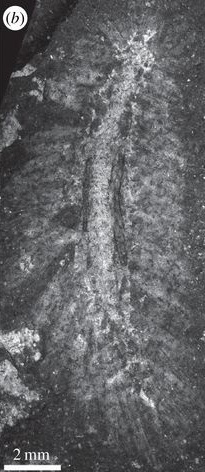Phragmochaeta canicularis on:
[Wikipedia]
[Google]
[Amazon]
''Phragmochaeta canicularis'' is an extinct animal belonging to the annelids and lived in the Early Cambrian ( Atdabanian in the local timescale, about 520 million years ago).''Phragmochaeta canicularis''
at
 Drawing from roughly 40 fossils ''Phragmochaeta'' consisted of about twenty segments, each of which carried structures typical of the annelids polychaetes (notochaetae and neurochetae). The notochaetae seemed to cover the entire dorsal surface, while the neurochaetae projected obliquely along the axis of the body. The head is not well known, but it seems there was no type of jaw. The intestine was unbent and has large longitudinal musculature.
Drawing from roughly 40 fossils ''Phragmochaeta'' consisted of about twenty segments, each of which carried structures typical of the annelids polychaetes (notochaetae and neurochetae). The notochaetae seemed to cover the entire dorsal surface, while the neurochaetae projected obliquely along the axis of the body. The head is not well known, but it seems there was no type of jaw. The intestine was unbent and has large longitudinal musculature.
 ''Polychaetes'' are rare in the Maotianshan Shales, in China, also dating back to the lower Cambrian. This is particularly surprising because the Chinese field has a very wide biological variety. The only Cambrian field containing polychaetes is that of Burgess Shale, in Canada, a little later. ''Phragmochaeta'', therefore, represents an exception as the oldest known polychaete.
''Polychaetes'' are rare in the Maotianshan Shales, in China, also dating back to the lower Cambrian. This is particularly surprising because the Chinese field has a very wide biological variety. The only Cambrian field containing polychaetes is that of Burgess Shale, in Canada, a little later. ''Phragmochaeta'', therefore, represents an exception as the oldest known polychaete.
at
Fossilworks
Fossilworks is a portal which provides query, download, and analysis tools to facilitate access to the Paleobiology Database
The Paleobiology Database is an online resource for information on the distribution and classification of fossil animals ...
.org Fossils have only been found in the Buen Formation at the Sirius Passet Lagerstätte, Greenland and the animal is probably the first polychaete.
Etymology
The genus name ''Phragmochaeta'' references the thatch−like appearance of the chaetae, hence reeds (Greek: ''phragmites'').Conway Morris & Peel, 2008, p.144 The speciesepithet
An epithet (, ), also byname, is a descriptive term (word or phrase) known for accompanying or occurring in place of a name and having entered common usage. It has various shades of meaning when applied to seemingly real or fictitious people, di ...
''canicularis'' is derived from the Latin for "dog" (''canis'') in reference to Sirius ("dog-star") Passet.Conway Morris & Peel, 2008, p.145
Description
 Drawing from roughly 40 fossils ''Phragmochaeta'' consisted of about twenty segments, each of which carried structures typical of the annelids polychaetes (notochaetae and neurochetae). The notochaetae seemed to cover the entire dorsal surface, while the neurochaetae projected obliquely along the axis of the body. The head is not well known, but it seems there was no type of jaw. The intestine was unbent and has large longitudinal musculature.
Drawing from roughly 40 fossils ''Phragmochaeta'' consisted of about twenty segments, each of which carried structures typical of the annelids polychaetes (notochaetae and neurochetae). The notochaetae seemed to cover the entire dorsal surface, while the neurochaetae projected obliquely along the axis of the body. The head is not well known, but it seems there was no type of jaw. The intestine was unbent and has large longitudinal musculature.
Lifestyle
It probably was abenthic
The benthic zone is the ecological region at the lowest level of a body of water such as an ocean, lake, or stream, including the sediment surface and some sub-surface layers. The name comes from ancient Greek, βένθος (bénthos), meaning "t ...
animal, which lived on the bottom of the sea and probably ate particles present on the seabed. This animal moved thanks to the neurochete, while the dorsal notochets provided protection.
Classification
This animal belonged to the annelates polychaetes, a group of animals currently represented by numerous marine species. Already in the middle Cambrian of Burgess Shales they were present with numerous species (''Burgessochaeta
''Burgessochaeta'' is an extinct genus of polychaete annelids from the Middle Cambrian. Its fossils have been found in the Burgess Shale in British Columbia, Canada. A total of 189 specimens of ''Burgessochaeta'' are known from the Greater Phyll ...
'', '' Canadia'', ''Peronochaeta
''Peronochaeta'' is a genus of annelid known from the Middle Cambrian
The Cambrian Period ( ; sometimes symbolized C with bar, Ꞓ) was the first geological period of the Paleozoic Era, and of the Phanerozoic Eon. The Cambrian lasted 53.4 m ...
''), but Phragmochaeta, antecedent of some millions of years, represents the oldest polychaete and was probably one of the most primitive.
Importance
References
Bibliography
* {{Taxonbar, from=Q3901706 Polychaetes Cambrian invertebrates Cambrian animals of North America Cambrian Greenland Fossils of Greenland Buen Formation Fossil taxa described in 2008 Cambrian genus extinctions